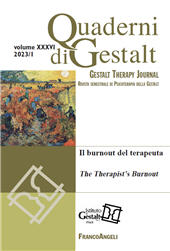Il burnout del terapeuta : il cortocircuito emotivo del guaritore ferito
29-49 p.
L'articolo intende illustrare i fattori di rischio burnout a cui il terapeuta è esposto. Soprat-tutto, focalizza una particolare situazione ricorrente nell'esperienza del clinico: il cortocircuito emotivo che nasce dall'incontro con pazienti che presentano una marcata affinità con lo sfondo del terapeuta, e che pertanto suscitano in lui particolare risonanza. Per prevenire il burnout, è auspicabile che il terapeuta abbandoni lo schema narcisistico del farsi carico della salvezza del paziente; che accetti la propria fallibilità e che sia disposto a met-tere al servizio dell'Altro le proprie paure e la propria fragilità. L'articolo si conclude con la presentazione di un esempio clinico utilizzando lo schema de-scrittivo dei "passi di danza" e con la proposta di favorire la spontaneità del terapeuta, la sua capacità di entrare pienamente in relazione con i pazienti e l'accettazione della sua vulnerabilità. [Testo dell'editore].
Like any professional in helping relationships, the therapist is subject to periods in which work-related stress can take on particularly intense dimensions, even to the point of burnout. This article, starting with the traditional definition of Burnout Syndrome, aims to illustrate the risk factors to which the therapist - specifically, the Gestalt therapist - is exposed. Above all, it focuses on a particular recurring situation in the clinician's experience: the emotional short-circuit that arises from encounters with patients who have a marked affinity with the therapist's background, and who therefore resonate with him/her. To prevent and/or deal with the risk of burnout, it is desirable that the therapist remains faithful to the gestalt therapeutic mentality; that he abandons the narcissistic scheme of taking charge of the patient's salvation; that he accepts his own fallibility and - as the myth of Chiron teaches - is willing to put his own fears and fragility at the service of the Other.
Finally, it is important that the therapist always keeps in mind the reciprocity of the desire to cure that binds him to the patient. The reciprocity that characterizes the therapeutic relationship results not only in the full involvement of the therapist who puts himself in the field; but also, in the evidence that the ther-apist himself, during the contact experience, deconstructs himself and comes out transformed as much as his patient, in terms of increased self-awareness. The Dance Steps tool with which it is possible to describe the adjustment of the patient-therapist dyad within the session is based precisely on the reciprocity of movements, perceptions and feelings that animate the two protagonists of the therapeutic experience. This kind of improvised choreography that expresses the vitality of mutual contact is also implemented through the patient's feeling of benevolence, who tries to reach out to his therapist (and be reached by him) out of love.
The therapeutic relationship is an intimate one, and this gives the term "reciprocity" a deeper con-notation, one that truly places the relationship on an equal footing. The article concludes with the presentation of a clinical example using the descriptive scheme of the Dance Steps and with the proposal to favour - among the protective and pre-ventive factors of Burnout - the therapist's spontaneity, his ability to enter fully into a relation-ship with patients and the acceptance of his vulnerability. [Publisher's text].
-
Articles from the same issue (available individually)
-
Information
ISSN: 2035-6994
KEYWORDS
- Burnout, guaritore ferito, reciprocità, cortocircuito emotivo, Passi di Danza
- Burnout, wounded healer, reciprocity, emotional shortcircuit, Dance Steps


